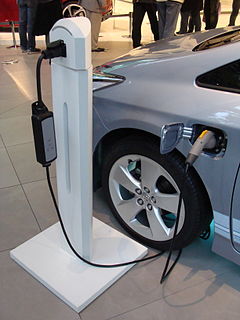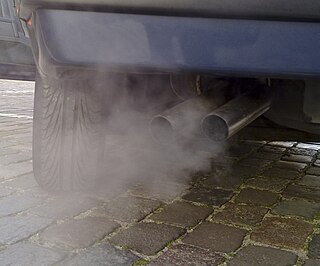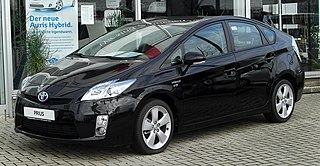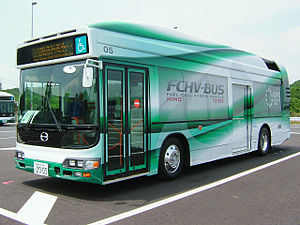The California Air Resources Board is the "clean air agency" in the government of California. Established in 1967 when then-governor Ronald Reagan signed the Mulford-Carrell Act, combining the Bureau of Air Sanitation and the Motor Vehicle Pollution Control Board, CARB is a department within the cabinet-level California Environmental Protection Agency.

The Honda Civic Hybrid is a variation of the Honda Civic with a hybrid electric powertrain. Honda introduced the Civic Hybrid in Japan in December 2001 and discontinued it in 2015. In the United States, it was the first hybrid automobile to be certified as an Advanced Technology Partial Zero-Emissions Vehicle (AT-PZEV) from the California Air Resources Board (CARB).
Vehicle emissions control is the study of reducing the emissions produced by motor vehicles, especially internal combustion engines.

Emission standards are the legal requirements governing air pollutants released into the atmosphere. Emission standards set quantitative limits on the permissible amount of specific air pollutants that may be released from specific sources over specific timeframes. They are generally designed to achieve air quality standards and to protect human life. Different regions and countries have different standards for vehicle emissions.
A partial zero emission vehicle, in the United States, is an automobile that has zero evaporative emissions from its fuel system, has a 15-year warranty on its emission-control components, and meets SULEV tailpipe-emission standards.
Super ultra-low emissions vehicle (SULEV) is a U.S. classification for passenger vehicle emissions. The classification is based on producing 90% fewer emissions than the average gasoline powered vehicle. The SULEV standard is stricter than the standard for LEV and ULEV, however not as strict as PZEV which meets the SULEV standard for tailpipe emissions, but has zero instead of reduced evaporative emissions. Japan also offers an SU-LEV classification, for vehicles that show a 75 percent reduction in emissions vis-à-vis the 2005 emissions standards.

A zero-emissions vehicle, or ZEV, is a vehicle that never emits exhaust gas from the onboard source of power.

The General Motors EV1 was an electric car produced and leased by General Motors from 1996 to 1999. It was the first mass-produced and purpose-designed electric vehicle of the modern era from a major automaker and the first GM car designed to be an electric vehicle from the outset.

A diesel particulate filter (DPF) is a device designed to remove diesel particulate matter or soot from the exhaust gas of a diesel engine.
The following items are commonly used automotive acronyms and abbreviations:
A low-emission vehicle is a motor vehicle that emits relatively low levels of motor vehicle emissions. The term may be used in a general sense, but in some countries it is defined in air quality statutes. Different groups of people show different interest in low emission vehicles
United States vehicle emission standards are set through a combination of legislative mandates enacted by Congress through Clean Air Act (CAA) amendments of 1970 and beyond, and executive regulations managed nationally by the Environmental Protection Agency (EPA), and more recently along with the National Highway Traffic Safety Administration (NHTSA). These standard cover common motor vehicle air pollution, including carbon monoxide, nitrogen oxides, and particulate emissions, and newer versions have incorporated fuel economy standards.
The BMW M56 is a 2.5 liter 184 PS straight-six engine. It is a re-engineered version of the BMW M54B25 engine, manufactured in order to meet SULEV regulations in 4 US states.

Pollution in California relates to the degree of pollution in the air, water, and land of the state of California. Pollution is defined as the addition of any substance or any form of energy to the environment at a faster rate than it can be dispersed, diluted, decomposed, recycled, or stored in some harmless form. The combination of three main factors are the cause of notable unhealthy levels of air pollution in California: the activities of over 39 million people, a mountainous terrain that traps pollution, and a warm climate that helps form ozone and other pollutants. Eight of the ten cities in the US with the highest year-round concentration of particulate matter between 2013 and 2015 were in California, and seven out of the ten cities in the US with the worst ozone pollution were also in California. Studies show that pollutants prevalent in California are linked to several health issues, including asthma, lung cancer, birth complications, and premature death. In 2016, Bakersfield, California recorded the highest level of airborne pollutants of any city in the United States.

The Toyota Prius is a full series-parallel hybrid electric compact car developed and manufactured by the Toyota Motor Corporation. The second generation Prius had been completely redesigned as a compact fastback. The XW20 series represented the second generation of the Toyota Prius, replacing its XW10 predecessor. The United States Environmental Protection Agency (EPA) and California Air Resources Board (CARB) rated the Prius as among the cleanest vehicles sold in the United States based on smog forming and toxic emissions in 2008. Toyota sold about 1,192,000 of the second generation Prius worldwide.

Government incentives for plug-in electric vehicles have been established around the world to support policy-driven adoption of plug-in electric vehicles. These incentives mainly take the form of purchase rebates, tax exemptions and tax credits, and additional perks that range from access to bus lanes to waivers on fees. The amount of the financial incentives may depend on vehicle battery size or all-electric range. Often hybrid electric vehicles are included. Some countries extend the benefits to fuel cell vehicles, and electric vehicle conversions.

Mobile source air pollution includes any air pollution emitted by motor vehicles, airplanes, locomotives, and other engines and equipment that can be moved from one location to another. Many of these pollutants contribute to environmental degradation and have negative effects on human health. To prevent unnecessary damage to human health and the environment, environmental regulatory agencies such as the U.S. Environmental Protection Agency have established policies to minimize air pollution from mobile sources. Similar agencies exist at the state level. Due to the large number of mobile sources of air pollution, and their ability to move from one location to another, mobile sources are regulated differently from stationary sources, such as power plants. Instead of monitoring individual emitters, such as an individual vehicle, mobile sources are often regulated more broadly through design and fuel standards. Examples of this include corporate average fuel economy standards and laws that ban leaded gasoline in the United States. The increase in the number of motor vehicles driven in the U.S. has made efforts to limit mobile source pollution challenging. As a result, there have been a number of different regulatory instruments implemented to reach the desired emissions goals.

The Hybrid Scorecard was created by the Union of Concerned Scientists (UCS) to give consumers a comprehensive comparison of hybrid electric vehicles available in the U.S. market. The UCS Hybrid Scorecard ratings take into considerations fuel economy as rated by the U.S. Environmental Protection Agency (EPA); the environmental benefits as compared to its similar or closest conventional internal combustion engine counterpart; how cost-effectively a particular hybrid achieves its environmental performance; and premium features that are bundled on a hybrid as standard equipment raising its purchase price.
Advanced vehicle technology competitions (AVTCs) are competitions sponsored by the United States Department of Energy, in partnership with private industry and universities, which stimulates "the development of advanced propulsion and alternative fuel technologies and provide the training ground for the next generation of automotive engineers."

The stock of plug-in electric vehicles in California is the largest in the United States, with cumulative sales of almost 670,000 plug-in cars by the end of 2019. California is the largest U.S. car market with about 10% of all new car sales in the country, but has accounted for almost half of all plug-in cars sold in the American market since 2011. Since November 2016, China is the only country market that exceeds California in terms of cumulative plug-in electric car sales.











